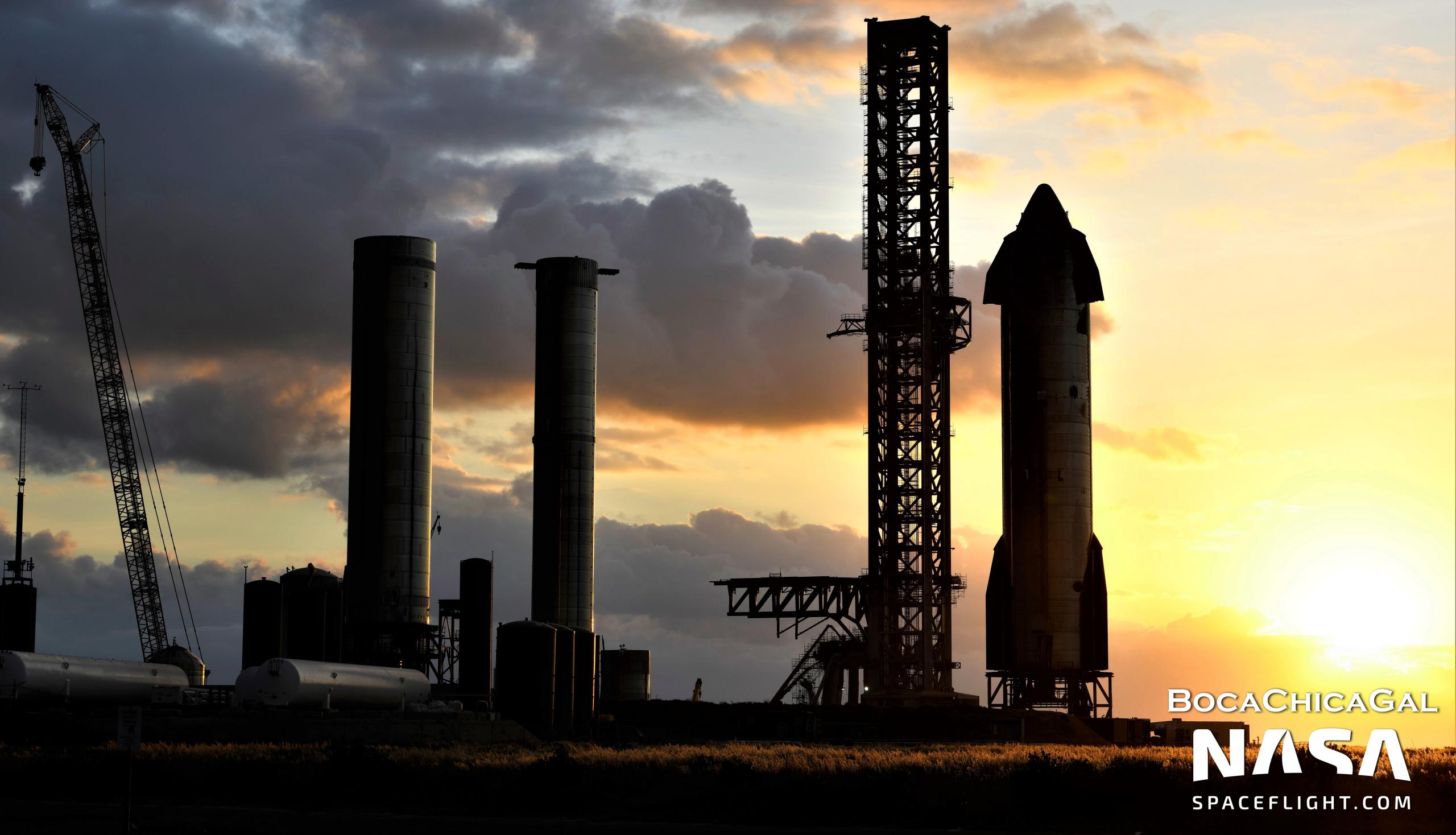

News
SpaceX putting the finishing touches on Starship’s orbital launch pad
SpaceX appears to have begun tying up a number of loose ends at Starship’s first orbital launch site, potentially setting the stage for major rocket testing CEO Elon Musk has stated could begin next month.
The list of tasks started or completed in just the last week or two is significant and each one is singularly focused on similar goals: pave the way for SpaceX to finish testing the first orbital-class Starship and Super Heavy booster and prepare for the first orbital launch attempt of the largest rocket ever built. While SpaceX’s progress towards those goals over the last several months has been decidedly slow relative to the pace of similar work completed in the very recent past, the nominal timeline Musk recently sketched out suggests that things could once again start to happen at a dizzying rate.
Launch Tower
Kicking off a jam-packed two weeks of minor to major finishing touches, SpaceX rigged Starbase orbital launch tower’s rocket-catching arms to a system of pulleys, and ‘drawworks’ in a process known as “reeving.” Thousands of feet of rope were first threaded from up, down, and through the ~145m (~440 ft) tower to act as a temporary guide for the next step. Once fully rigged, anchored, and attached to the start of the steel cable actually meant to operate the system, the tower’s ‘drawworks’ was activated for the first time to reel in the guide rope – simultaneously installing the steel cable. By November 9th, the process was more or less complete, leaving the steel cable firmly attached to the tower’s giant rocket-catching arms and able to carry their significant weight.
Thanks Ralph and @StarshipGazer! Updated diagram below. pic.twitter.com/lUvcbshKGs— LunarCaveman (@LunarCaveman) November 10, 2021
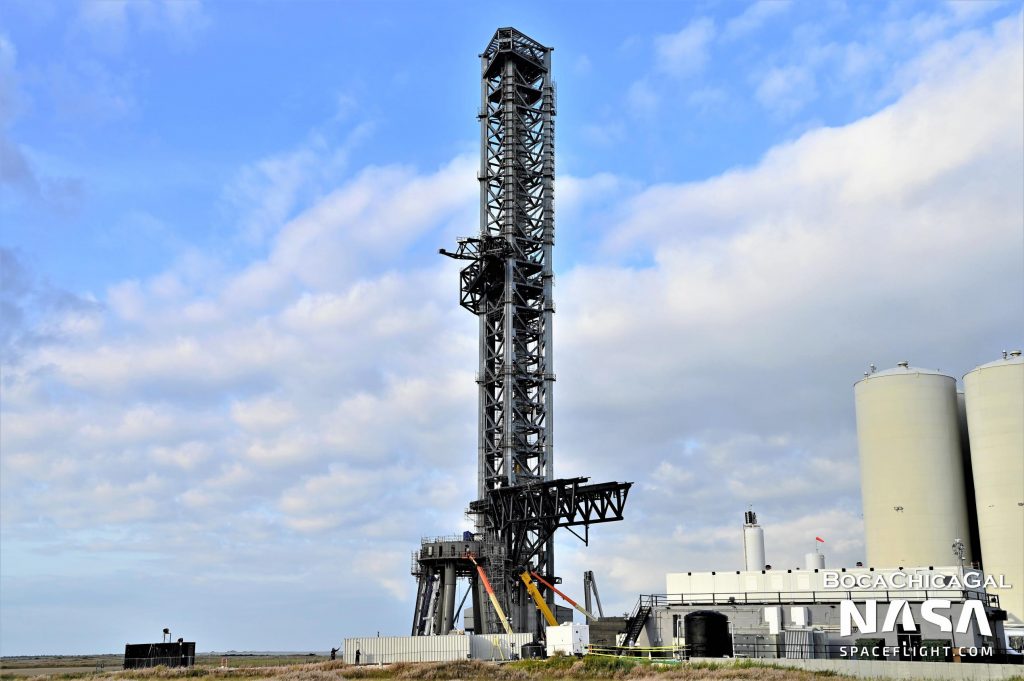
SpaceX hasn’t quite finished installing those arms and does not appear to have picked up the slack in the cable that will eventually lift them up and down the tower, but the arm assembly’s first real move is likely just a few weeks away. Notably, a bit of scaffolding around the tower’s ‘legs’ still needs to be removed before the catch arms can freely roll up and down rails welded to their exteriors. SpaceX will also need to complete shakedown testing of the arms themselves, ensuring that the massive structures’ hydraulic, electrical, and mechanical systems are all working properly.
In the near future, those arms will be used to grab, lift, and install Super Heavy boosters and stack Starships on top of them, while SpaceX also hopes to eventually use them to catch boosters and ships out of mid-air. At least for the former role, a separate arm visible about halfway up the tower in the photo above will also be crucial. Known as the tower’s Starship quick-disconnect (QD) arm or claw, SpaceX has also made significant progress on the structure, practically completing it in the last few days.
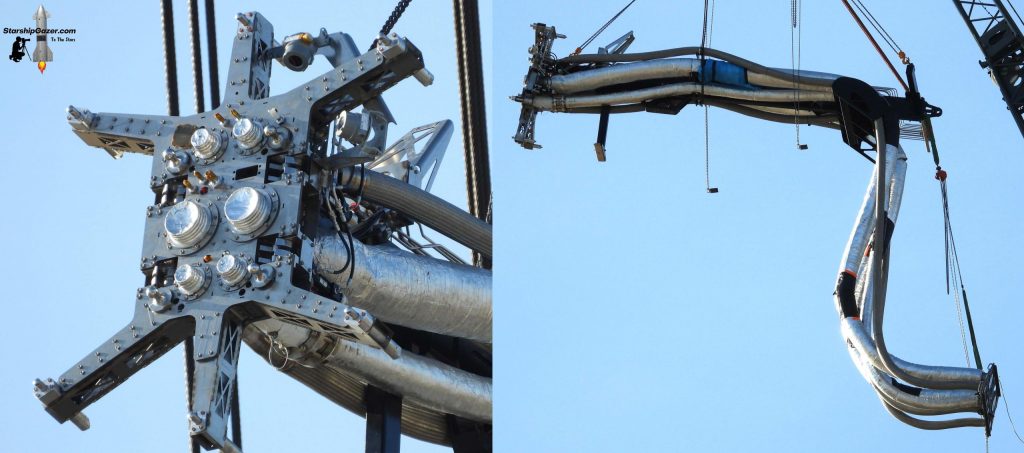
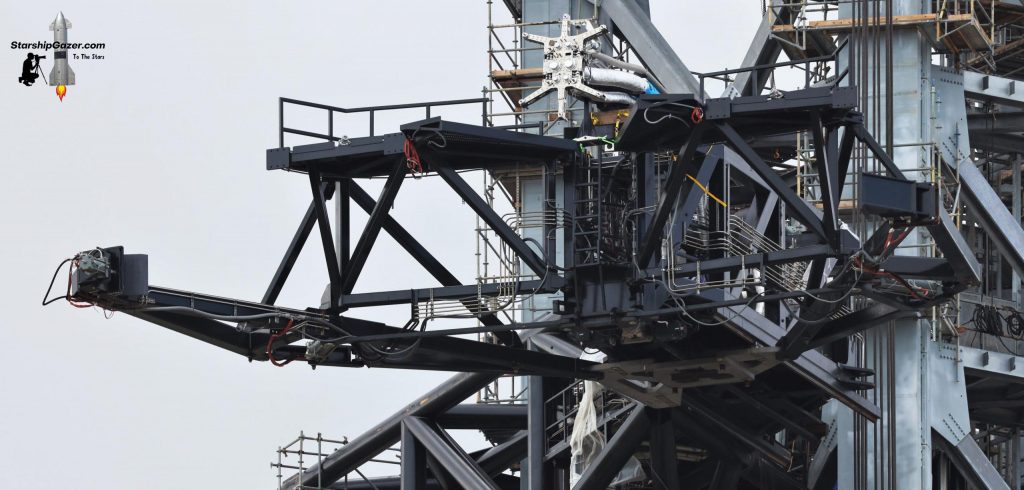
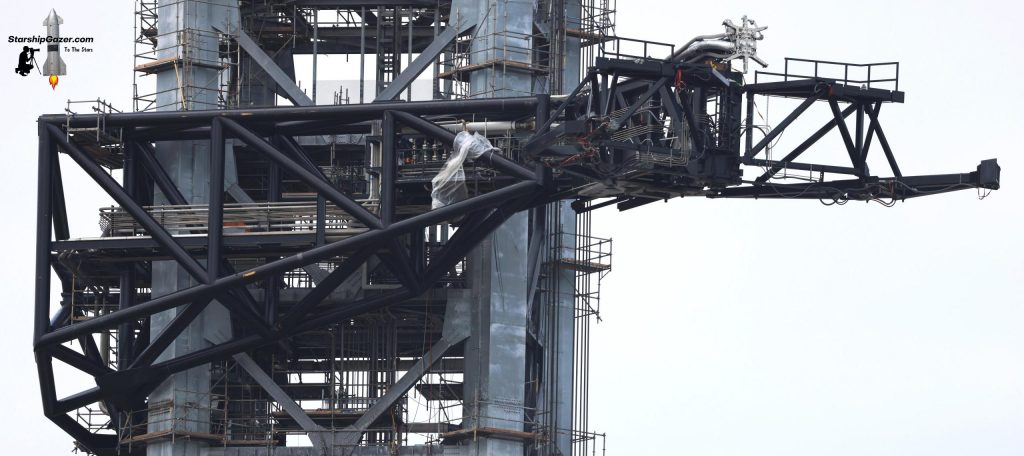
Designed to fuel Starship and stabilize the top of Super Heavy with its claw, the Starship ‘QD arm’ is also able to swing left and right both to quickly back away during launches and to make room for the catch arms during rocket catches and ship/booster stacking operations. Last week, SpaceX technicians finished plumbing the arm, which requires thousands of feet of insulated steel tubes to connect to the pad’s propellant tanks. This week, on November 23rd, SpaceX installed the last major component of the arm – the actual quick disconnect (QD) mechanism that will connect to Starship to supply power, communications, and propellant.
A few small actuators likely still need to be installed and the QD mechanism itself will have to be fully connected to pad systems but the QD arm now appears to be more or less complete and should soon be ready to fuel Starships installed on top of Super Heavy boosters.
Launch Mount
Last but not least, SpaceX performed multiple tests of the pad’s ‘orbital launch mount’ – the giant, steel structure that will support Super Heavy, hold the booster down during testing and before liftoff, and supply it with thousands of tons of propellant. On November 21st, SpaceX completed the first of those tests, seemingly venting an unknown gas out of the mount. More likely than not, it was the first simultaneous test of all 20 of the mounts Raptor Boost engine gas supplies, which – having no need to reignite in flight – will rely on ground gas supplies for ignition. Each of Super Heavy’s 20 outer Raptor engines has a small umbilical and quick disconnect mechanism, resulting in what is likely the most mechanically complex rocket launch mount ever built.
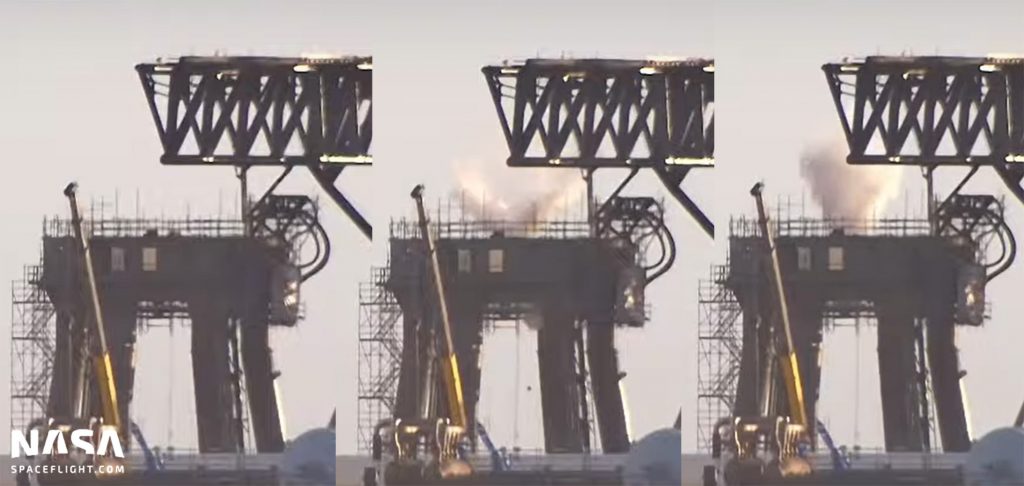
On November 22nd, the orbital launch mount’s booster quick disconnect panel actuated for the first time, showing off the first glimpse of how it will move forward to connect to Super Heavy after a booster is installed on the mount. To prevent its sensitive components from being practically incinerated each launch, the mount’s QD panel will also need to rapidly move away from Super Heavy just before liftoff.
Aside from simply avoiding direct impingement from the several-thousand-degree plume created by 29-33 Raptor engines at full thrust, that movement will also tie into some kind of hood, seamlessly actuating hatches that will close to truly protect the device. That hood was itself spotted for the first time on November 21st and will likely be installed on the launch mount and over the naked QD mechanism in the very near future.
Finally, over the last week or so, SpaceX has begun installing a number of new pipes on and around the launch mount, likely assembling a water deluge system that will help manage the extreme thermal and acoustic environment created by the most powerful rocket in history shortly before and after liftoff. When activated, a spray bar circling the mount’s full interior circumference will likely unleash several tons of water per second in a giant artificial waterfall, hopefully preventing Super Heavy from damaging itself with the sheer sound produced by its Raptor engines or violently eroding the surrounding pad or launch mount legs with its plume.
Ultimately, once all the tower, arm, and mount work described above is completed, the only obvious thing standing between the orbital launch pad and the first Super Heavy booster testing and first orbital Starship launch will be the delivery of liquid methane fuel, which could easily begin any day now.
Elon Musk
Elon Musk confirms Grok 4 launch on July 9 with livestream event
The rollout will be accompanied by a livestream at 8 p.m. Pacific Time.

Elon Musk has officially confirmed that Grok 4, the latest version of xAI’s large language model, will launch on July 9. The rollout will be accompanied by a livestream at 8 p.m. Pacific Time, hosted on xAI’s official account on X.
xAI goes straight to Grok 4
Back in May, leaks indicated that xAI was getting ready to ship Grok 3.5. Considering Musk’s recent comments, however, it appears that the artificial intelligence startup would be focusing on the large language model’s fourth iteration instead. As noted in a Financial Express report, users on X have sighted references to Grok 4 in the lead up to the update’s launch, such as “grok-4-prod-mimic” and “Grok 4 Code.”
Musk’s Grok 4 announcement comes as AI competition intensifies between major players including OpenAI, Google, and xAI. With Musk’s Colossus supercomputer fully operational in Memphis, xAI appears to be accelerating its AI product roadmap.
Musk pushes Grok toward political neutrality
Grok 4’s launch also follows a recent controversy involving political bias, as noted in a CNN report. Last week, Grok responded to a user on X stating that political violence in the U.S. since 2016 had come more from the political right than the left. The chatbot noted in a later reply that its answer was based on information from sources like Reuters, the Journal of Democracy, and University of Maryland studies.
Musk stated that Grok’s response was a “major fail.” “Major fail, as this is objectively false. Grok is parroting legacy media. Working on it,” he wrote in a post on X. By the end of June, Musk noted that he was “grinding all night with the xAI team” and that they were making “good progress.” He also stated that the model “Will be called Grok 4. Release just after July 4th. Needs one more big run for a specialized coding model.”
News
Tesla opens massive solar Supercharger station in California
The Supercharger opened to customers ahead of Fourth of July weekend, while Tesla continues phase two of construction on the site.

Tesla has officially launched the first several Supercharging posts at a massive station in California, notably including solar canopies and grid-scale batteries to offer completely renewable charging.
Last week, Tesla announced on X that it opened the first 84 Supercharger stalls of a planned 168-stall station in Lost Hills, California. Additionally, the massive Supercharger project features 11MW of solar canopies and 10 Megapack batteries for off-grid charging powered entirely by solar energy.
Tesla completed the first phase of the project just days ahead of the busy Fourth of July holiday weekend, adding that initial construction took just eight months. In addition to the remaining charging stalls, Tesla says it’s building a set of lounge areas, renderings of which can be seen below alongside current photos of the site.
Notably, the site also includes V4 charging posts for the company’s latest available charging speeds, and it’s located near the busy junction between I-5 and Highway 46 in Kern County.
“Thank you [Kern County] and [PG&E] for collaboration and approvals,” Tesla wrote in a follow-up post.

Credit: Tesla Charging | X

Credit: Tesla Charging | X

Credit: Tesla Charging | X

Credit: Tesla Charging | X
Tesla Supercharger Maps for North America, Europe, and Asia pic.twitter.com/0U5r0XRPyo
— TESLARATI (@Teslarati) July 2, 2025
READ MORE ON TESLA SUPERCHARGERS: Tesla launches ultra-fast V4 Superchargers in China for the first time
Testing at the LA Diner, plus Musk update on potential Tesla solar Gigafactory
The huge Tesla Supercharger station completed phase one of construction fairly quickly, especially given how long Tesla has been working on its unique Los Angeles diner, drive-in, and Supercharger location. Still, the company was seen performing some testing at the nearly-completed charging station earlier this month, and will reportedly be holding a job fair.
Elon Musk also responded on Monday morning to a post on X, suggesting that Tesla is “thinking about” building a U.S.-based solar Gigafactory in order to help support increased power needs with AI growth, and to bolster domestic solar production.
Tesla is building a new UFO-inspired Supercharger in the heart of Alien country
News
Tesla driver walks away from major accident with minor injuries
The driver sustained only minor injuries, and the exact cause of the crash remains under investigation.

The driver of a Tesla Model Y survived and walked away from a harrowing accident on Monday in California, only sustaining minor injuries despite the vehicle being impaled by a guardrail.
On Monday morning around 4:34 a.m., the Los Banos division of the California Highway Patrol (CHP) responded to the accident on I-5 near Panoche Road, involving a 23-year-old in a Tesla Model Y. According to a post on social media, the driver veered off the road for unknown reasons in the northbound lane, before crashing directly into the guardrail and impaling the vehicle.
You can read the full message and photos from Los Banos CHP below, as were shared in a Facebook post on Monday afternoon.
This morning a Tesla model y was traveling in the #1 northbound lane of I-5 north of Panoche Rd. For unknown reasons driver allowed V-1 to veer off the roadway, travel through a dirt center divide, and crashed into the fixed metal guardrail. Lucky for the driver he only sustained minor injuries and was able to walk away. Driving a vehicle requires 100% attention to the road. Avoid distractions and focus on driving.

Credit: CHP Los Banos (via Facebook)

Credit: CHP Los Banos (via Facebook)

Credit: CHP Los Banos (via Facebook)
In a statement to SFGate, CHP officer Myles Anderson said that the driver only sustained minor injuries, while no arrests are made and drugs and alcohol are not suspected to have been involved. The report also notes that Tesla’s “cruise control and lane assistance features” were activated, according to Anderson. However, it’s not entirely clear if this is referring to Supervised Full Self-Driving (FSD), or to the cruise control and lane assist features baked into Autopilot.
At the time of writing, CHP has not yet responded to Teslarati’s request for clarification and additional details on the matter.
Tesla Crash Safety Ratings across its lineup: pic.twitter.com/ny30R7ceji
— TESLARATI (@Teslarati) July 1, 2025
READ MORE ON TESLA SAFETY: Tesla rolls out crucial new safety feature aimed at saving children
The news comes after Tesla has touted its vehicles as incredibly safe for many years. In December, for example, the company highlighted receiving top safety scores from regulators on four different continents throughout the world, including from the National Highway Traffic Safety Administration (NHTSA) and the Insurance Institute of Highway Safety (IIHS) in the U.S.
Tesla has also listed the goal of making its vehicles the safest on the road throughout the years, both in the overall design of its vehicles and in its Autopilot and Full Self-Driving (FSD) programs.
Tesla Model 3 ranks as the safest new car in Europe for 2025, per Euro NCAP tests
-

 Elon Musk1 week ago
Elon Musk1 week agoTesla investors will be shocked by Jim Cramer’s latest assessment
-

 News2 weeks ago
News2 weeks agoTesla Robotaxi’s biggest challenge seems to be this one thing
-

 News2 weeks ago
News2 weeks agoWatch the first true Tesla Robotaxi intervention by safety monitor
-

 Elon Musk2 weeks ago
Elon Musk2 weeks agoA Tesla just delivered itself to a customer autonomously, Elon Musk confirms
-

 News2 weeks ago
News2 weeks agoTesla Robotaxi rollout proves that Elon Musk still delivers, even if it’s late
-

 Elon Musk2 weeks ago
Elon Musk2 weeks agoxAI welcomes Memphis pollution results, environmental groups push back
-

 Elon Musk2 weeks ago
Elon Musk2 weeks agoElon Musk commends Tesla team on successful Robotaxi launch
-

 Elon Musk2 weeks ago
Elon Musk2 weeks agoElon Musk confirms Tesla Optimus V3 already uses Grok voice AI


















